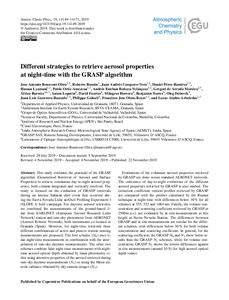Por favor, use este identificador para citar o enlazar este ítem:
http://hdl.handle.net/20.500.11765/11682
Different strategies to retrieve aerosol properties at night-time with the GRASP algorithm
| Título : | Different strategies to retrieve aerosol properties at night-time with the GRASP algorithm |
| Autor : | Benavent Oltra, José Antonio; Román, Roberto; Casquero Vera, Juan Andrés; Pérez Ramírez, Daniel; Lyamani, Hassan; Ortiz Amezcua, Pablo; Bedoya Velásquez, Andrés Esteban; Arruda Moreira, Gregori de; Barreto Velasco, África



|
| Palabras clave : | GRASP algorithm; Aerosol properties; Atmospheric aerosol optical; AERONET |
| Fecha de publicación : | 2019 |
| Editor: | European Geosciences Union |
| Citación : | Atmospheric Chemistry and Physics. 2019, 19(22), p. 14149–14171 |
| Versión del editor: | https://dx.doi.org/10.5194/acp-19-14149-2019 |
| Resumen : | This study evaluates the potential of the GRASP algorithm (Generalized Retrieval of Aerosol and Surface Properties) to retrieve continuous day-to-night aerosol properties, both column-integrated and vertically resolved. The study is focused on the evaluation of GRASP retrievals during an intense Saharan dust event that occurred during the Sierra Nevada Lidar aerOsol Profiling Experiment I (SLOPE I) field campaign. For daytime aerosol retrievals, we combined the measurements of the ground-based lidar from EARLINET (European Aerosol Research Lidar Network) station and sun–sky photometer from AERONET (Aerosol Robotic Network), both instruments co-located in Granada (Spain). However, for night-time retrievals three different combinations of active and passive remote-sensing measurements are proposed. The first scheme (N0) uses lidar night-time measurements in combination with the interpolation of sun–sky daytime measurements. The other two schemes combine lidar night-time measurements with night-time aerosol optical depth obtained by lunar photometry either using intensive properties of the aerosol retrieved during sun–sky daytime measurements (N1) or using the Moon aureole radiance obtained by sky camera images (N2). Evaluations of the columnar aerosol properties retrieved by GRASP are done versus standard AERONET retrievals. The coherence of day-to-night evolutions of the different aerosol properties retrieved by GRASP is also studied. The extinction coefficient vertical profiles retrieved by GRASP are compared with the profiles calculated by the Raman technique at night-time with differences below 30 % for all schemes at 355, 532 and 1064 nm. Finally, the volume concentration and scattering coefficient retrieved by GRASP at 2500 m a.s.l. are evaluated by in situ measurements at this height at Sierra Nevada Station. The differences between GRASP and in situ measurements are similar for the different schemes, with differences below 30 % for both volume concentration and scattering coefficient. In general, for the scattering coefficient, the GRASP N0 and N1 show better results than the GRASP N2 schemes, while for volume concentration, GRASP N2 shows the lowest differences against in situ measurements (around 10 %) for high aerosol optical depth values. |
| Patrocinador: | This research has been supported by the European Union through the H2020 programme (ACTRIS-2, grant no. 654109) and the Spanish Ministry of Economy and Competitiveness (projects CMT2015-66742-R, CGL2016-81092-R, CGL2017-85344-R, RTI2018-097864-B-I00 and CGL2017-90884-REDT). |
| URI : | http://hdl.handle.net/20.500.11765/11682 |
| ISSN : | 1680-7316 1680-7324 |
| Colecciones: | Artículos científicos 2019-2022 |
Ficheros en este ítem:
| Fichero | Descripción | Tamaño | Formato | ||
|---|---|---|---|---|---|
| acp-19-14149-2019.pdf | 8,22 MB | Adobe PDF |  Visualizar/Abrir |
Los ítems de Arcimis están protegidos por una Licencia Creative Commons, salvo que se indique lo contrario.





